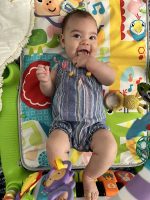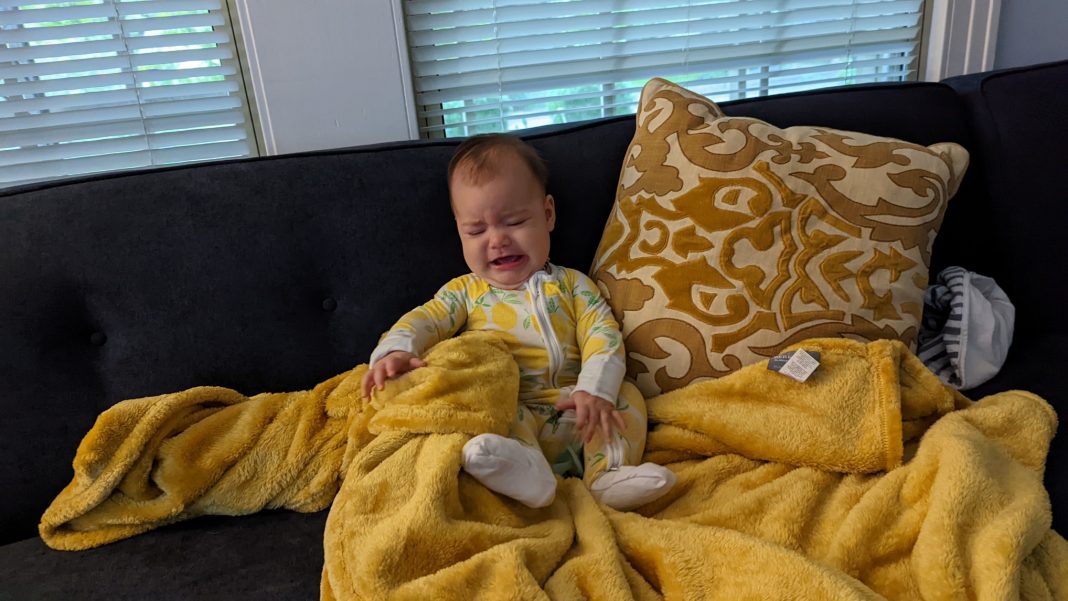If you’re like me, you only know the term barnacle baby if you actually have one. And that’s because you had to figure out what the heck you just created. They are one-of-a-kind, sensitive, unique little humans.
So barnacle mama, I’m writing this article for you. There are a lot of us out there, but our society and culture does not do a very good job of nurturing us barnacle mamas and babies.
I see you. I’m one of you. This is for you.
RELATED READING :: Babywearing 101
Of course, all babies cry.
Crying is the way babies communicate, and all of us mamas know that. We expect our babies to cry to tell us they’re hungry, sleepy, wet, scared, uncomfortable, bored, etc. And if all needs are met, what else is there to cry about? That is exactly how I expected my baby to be.
What I did NOT expect was for my baby to cry every single time I put her down.
Anywhere. Her crib, her bassinet, her dockatot, her changing table, my bed, the couch, the swing. It didn’t matter. She cried. In fact, the only time she did not cry was when she was being held.
Hence the term “barnacle baby”. In other words, she is attached to me like a barnacle to a boat. These babies are also known as “velcro babies” or “koala babies”, as I’ve learned recently from my Aussie friends.

Georgia is also what Dr. Sears would classify as a “high needs” baby. She has a sensitive, intense temperament and needs all the TLC we can give her. Most of the time, being held wouldn’t even do the trick. We couldn’t sit down or really stay still. Being held with constant movement was the only thing that soothed her. I learned how to wear her using a ring sling really quickly. That, and bouncing on the yoga ball were our saving grace. Also, we contact nap and she sleeps with us. Because that is the only way we all get great sleep, which is of the highest priority in our household. Never expected that one to occur, but here we are.


And before you direct me to any medical concerns, we ruled out all of them.
Georgia had a tongue tie that was taken care of when she was three days old with additional chiropractic care and body work. I went dairy-free from weeks three to six without seeing any behavior, gas, or stool changes in her. We tried gas drops anyway, but no changes. She simply likes to be close to people. Nothing relieves her like being held.

Naturally, the older Georgia has gotten (now five months-ish), the more comfortable she has become with being a human. She can play for ten to fifteen minutes independently on her play mat before needing to be picked up so I can at least scarf down some breakfast. Or go to the bathroom. Or just give my arms a break. It doesn’t sound like much time, and it’s not, but it’s 10-15x more than what I used to have.
Caring for her has put me down the rabbit hole of infant research.
I’ve taken a deep dive into topics ranging from biologically normal sleep and sleep training to brain development and secure attachment theory.
I can honestly say it’s been really fun. I am a nerd, and I love to learn. Especially about things I can apply in everyday life. With my extensive academic and professional background in healthy nervous system function, this new research has opened up an entirely different aspect of health for me.
What I have uncovered really comes down to this…
It is of the highest importance for me to respond to her cues while showing up for her as my healthiest self.
Babies do not have the ability (brain development) to regulate their own nervous systems. Self-soothing is a skill that comes with higher brain development and sophistication. All babies require their caregiver to model regulation for them, to co-regulate. They need this done on a moment-to-moment basis to develop healthy and fully.
Some babies have a very calm, chill temperament. These babies are okay napping or sleeping independently. Some babies, like Georgia, have no chill. And they require complete responsiveness from their caregivers to get through their day.
This can be triggering for moms. It was for me. I have had to use every single tool in my toolbox to regulate my own nervous system to better care for her. And I’ve even had to learn some new ones. But that is for a different article!

Here’s the key:
When I am taking care of myself, I can take better care of her. And since she, just like all babies, models her regulation off of me, the happier and healthier I am, the happier and healthier she is. The more responsive I am to her and her priority need of closeness, the more secure and independent she becomes.
If you have a barnacle, and you know if you do, don’t fight their nature. Take a deep breath and remember that taking better care of yourself makes taking care of them so much easier.










